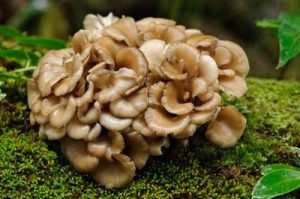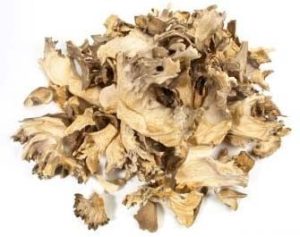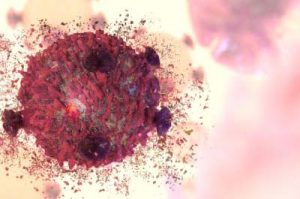
Every person is unique!
Our experienced team will be happy to advise you in detail and free of charge on all matters relating to your health. Book your consultation appointment now:
Maitake - lose weight naturally with vital mushrooms
January 15, 2022
Dr. Dorothee Bös et al.
Behind the name Maitake is not only a tasty edible mushroom, but also a great supporter of health. Popular especially in Japan, the mushroom has a rather peculiar appearance, from which its German name “Klapperschwamm”. In alternative medicine, its powder is used mainly for problems with fat metabolism. Moreover, it is a great help in diabetes, diarrhea, cancerous diseases, osteoporosis as well as polycystic ovaries. Read in this article about the scientific background and the state of research on the mode of action of the medicinal mushroom Maitake.
What is the Maitake?
One medicinal mushroom - many names
The name “Maitake” comes from the Japanese. “Mai” means something like “dance” and “take” is the Japanese word for mushroom. Literally translated, the maitake is therefore the “dancing mushroom”. In the botanical sense, this vital mushroom belongs to the porcini. More precisely, this is a foliage spore with the Latin name “Grifola frondosa”. It probably got its German name “Klapperschwamm” because of the sponge-like appearance of its eyrie and the fact that its hats “rattle” when you shake it.
The Chinese have given their popular medicinal and edible mushroom the melodious title “Hui Shu Hua”. The translation is roughly “gray tree flower”. No less onomatopoeic are the English terms “Hen of the woods” and “Sheep’s head,” both alluding to the maitake’s peculiar appearance.
How the maitake mushroom grows
 Branches emerge from the thick stem of the maitake and become thinner and thinner. At the ends of these branches are the spatulate, thin-fleshed hats. These grow closely next to and on top of each other. The stem attaches to the side of the cap in each case. Due to the superimposed mushroom roofs, which are between two and six centimeters wide, the Maitake acts like a small sponge. Sometimes individual mushroom caps can grow up to 12 cm wide. They are always gray-brown in color and have white pores on the underside.
A cluster of several Maitake mushrooms standing close together can reach a diameter of up to 50 centimeters. To the layman, this plant on the forest floor then appears like a small bush. A single mushroom reaches a stately weight of between five and fifteen kilograms at full size. At a superficial glance, maitake looks somewhat similar to polyporus (oak hare).
Branches emerge from the thick stem of the maitake and become thinner and thinner. At the ends of these branches are the spatulate, thin-fleshed hats. These grow closely next to and on top of each other. The stem attaches to the side of the cap in each case. Due to the superimposed mushroom roofs, which are between two and six centimeters wide, the Maitake acts like a small sponge. Sometimes individual mushroom caps can grow up to 12 cm wide. They are always gray-brown in color and have white pores on the underside.
A cluster of several Maitake mushrooms standing close together can reach a diameter of up to 50 centimeters. To the layman, this plant on the forest floor then appears like a small bush. A single mushroom reaches a stately weight of between five and fifteen kilograms at full size. At a superficial glance, maitake looks somewhat similar to polyporus (oak hare). Occurrence and use of the rattling sponge
Simply request free information brochures now!

After you have sent the completed form, you will receive an e-mail with a download link.
What is Maitake Powder?
 Maitake powder is usually obtained from cultivated mushrooms. For this purpose, the mushrooms are gently dried after harvesting and then carefully ground into powder. Since the unsaturated fatty acids of maitake should not come into excessive contact with oxygen, and the mushroom protein should not come into contact with moisture, the powder is usually stored in capsules and well-sealed containers. The advantage of powder over the fresh mushroom is clearly the longer shelf life, as well as easier dosage for medicinal uses. It is important for the effectiveness that the Maitake is dried at a maximum of 40° Celsius. Otherwise, many of its valuable substances are lost.
The following is a brief overview of the ingredients of maitake and their importance for human health.
Maitake powder is usually obtained from cultivated mushrooms. For this purpose, the mushrooms are gently dried after harvesting and then carefully ground into powder. Since the unsaturated fatty acids of maitake should not come into excessive contact with oxygen, and the mushroom protein should not come into contact with moisture, the powder is usually stored in capsules and well-sealed containers. The advantage of powder over the fresh mushroom is clearly the longer shelf life, as well as easier dosage for medicinal uses. It is important for the effectiveness that the Maitake is dried at a maximum of 40° Celsius. Otherwise, many of its valuable substances are lost.
The following is a brief overview of the ingredients of maitake and their importance for human health. EXPERIENCE REPORTS
"After two passed pneumonias, I had bronchitis, congested sinuses, low blood pressure, depression and elevated cholesterol levels. Thanks to cordyceps, shiitake and reishi, everything is eliminated. Blood levels are back to normal."
General nutrients
Medically active substances
 Other polysaccharides from the maitake mushroom and their medicinal significances are …
Other polysaccharides from the maitake mushroom and their medicinal significances are …
- the X fraction: antidiabetic
- MZ-fraction: antitumoral, immunomodulatory
- MT alpha-glucan: hypoglycemic, hypolipid, antioxidant and immunomodulatory.
- Grifolan: immunomodulating
How does the Maitake work?
Regulation of fat metabolism
Since time immemorial, maitake has been a proven vital mushroom for lowering blood lipid levels. Yet never in human history have there been so many overweight people and people with elevated cholesterol levels. That is why the rattling sponge plays a leading role in the fight against metabolic syndrome, especially today. In addition to obesity and elevated blood lipid levels, this is characterized by high blood pressure and often type 2 diabetes. Due to its valuable ingredients, maitake not only has a hypolipidemic effect, but also supports affected people in many ways to reduce weight. For example, its positive influence on the intestinal flora is also an important factor.
How maitake lowers blood lipid levels
Scientific studies have shown that both total cholesterol and LDL (“bad”) cholesterol levels drop when people take Maitake capsules or powder regularly over several months. The same applies to triglyceride levels and uric acid. At the same time, the level of HDL cholesterol (“good” cholesterol) remains constant. More detailed studies have shown that the cholesterol-lowering effect of maitake is due to two different mechanisms. First, it reduces the activity of certain enzymes in the liver, slowing the biosynthesis of cholesterol. On the other hand, the substances from the rattle sponge increase the activity of other enzymes responsible for the conversion of cholesterol into bile acid. With the help of dietary fiber and chitin from the medicinal mushroom, the amounts of bile acid that then accumulate are easily bound in the intestine and finally excreted.
Healthy liver
Fatty liver usually occurs in association with metabolic syndrome. This can develop independently of alcohol consumption and weight. Nowadays, almost all of us consume too much saturated fat, too much sugar and artificially added fructose. Since the body converts sugar into fat to store energy, not only fat but also sugar from our food can lead to fatty liver. Maitake counters this process by reducing the storage of triglycerides in liver cells.
At the same time, its antioxidants bind free radicals in the liver. As a result, less fat (LDL) oxidizes there. Since oxidized fats have the negative property of being deposited on the walls of blood vessels, causing plaques, the antioxidants from the maitake mushroom reduce the risk of atherosclerosis in this way. With regard to the liver, it is also worth mentioning that taking Maitake capsules is an effective preventive measure regarding hepatitis. This is due to the anti-inflammatory properties of the vital mushroom.
Lip and lymphedema
Due to its regulating effect on the fats in the body, the rattle sponge is the most important fungus for the therapy of lipedema. If lipedema occurs in combination with lymphedema, mycotherapy recommends the complementary use of Polyporus or Poria cocos. Indeed, both have a draining effect. Good results can also be achieved in lymphatic lipedema with a whole-food plant-based diet.
Antihypertensive
Maitake has made a name for itself in both the preventive and therapeutic fields for high blood pressure. On the one hand, it reduces the likelihood of developing arteriosclerosis, which also reduces the risk of high blood pressure. On the other hand, it influences the renin-angiotensin-aldosterone system, which is responsible for the regulation of blood pressure. Lowering blood pressure-increasing uric acid appears to be another mechanism. Especially in age-related hypertension, these effects are a helpful countermeasure. In a study on rats, administration of maitake powder reduced systolic blood pressure by 15 mmHg within two months.
Prevention and therapy of diabetes type 2
 Diabetics suffer from an elevated blood sugar level combined with a reduced uptake of sugar into the body’s cells – so-called “insulin resistance” – usually caused by malnutrition. Insulin is responsible for introducing the sugar into the cells. People with diabetes produce less insulin in the long term, while at the same time insulin sensitivity declines, so more insulin would actually be needed. Maitake supports the organism on several levels. On the one hand, it stimulates the production of insulin in the islet cells of the pancreas. At the same time, it also increases the sensitivity of cells to insulin. The F2 and F3 polysaccharides and the SX glycoprotein fraction are primarily responsible for this. Increasing sensitivity directly counteracts insulin resistance. The utilization of blood sugar by the cellular power plants improves automatically. In addition, the MT alpha-glucans contained in maitake have a direct blood sugar-lowering effect.
Diabetics suffer from an elevated blood sugar level combined with a reduced uptake of sugar into the body’s cells – so-called “insulin resistance” – usually caused by malnutrition. Insulin is responsible for introducing the sugar into the cells. People with diabetes produce less insulin in the long term, while at the same time insulin sensitivity declines, so more insulin would actually be needed. Maitake supports the organism on several levels. On the one hand, it stimulates the production of insulin in the islet cells of the pancreas. At the same time, it also increases the sensitivity of cells to insulin. The F2 and F3 polysaccharides and the SX glycoprotein fraction are primarily responsible for this. Increasing sensitivity directly counteracts insulin resistance. The utilization of blood sugar by the cellular power plants improves automatically. In addition, the MT alpha-glucans contained in maitake have a direct blood sugar-lowering effect.
In addition to the mechanisms described above, the rattling sponge exerts other beneficial influences on the body that make life easier for diabetics of both type 2 and type 1. All diabetics have in common that they suffer from increased oxidative stress due to unfavorable metabolic processes. Therefore, they all benefit from the antioxidants of maitake. In addition, the medicinal mushroom promotes the body’s own antioxidant enzymes such as superoxide dismutase and glutathione peroxidase. Another property of the maitake mushroom that benefits all people with high blood sugar is the inhibition of alpha-glucosidase activity. This means that only little starch from food is converted into disaccharides. Consequently, the blood sugar level rises less strongly or not at all. This is probably caused by certain fatty acids from the vital mushroom.
Bones and joints
 The human skeleton is relieved by the effect of Maitake on the metabolism in two respects. On the one hand, a reduction in weight, which the rattling sponge does support, always means less stress on the bones and especially the joints. In addition, abdominal fat causes mild chronic inflammation in the body, which affects the joints, among other things. If the abdominal fat decreases, the inflammation also decreases automatically. In addition, maitake also has direct anti-inflammatory ingredients.
On the other hand, maitake has a regulating effect on the body’s metabolism. Central to joint problems is uric acid. The vital mushroom not only ensures that less uric acid is formed, but also that it is excreted more. As a result, uric acid crystals are no longer deposited in the joints, where they cause inflammation and the decline of cartilage. This effect is particularly valuable for women after menopause, because their uric acid is excreted more poorly due to lower estrogen levels. The same women also benefit from the promoting influence of the maitake mushroom on the bone-forming activity of osteoblasts. Indeed, this effectively counteracts osteoporosis.
The human skeleton is relieved by the effect of Maitake on the metabolism in two respects. On the one hand, a reduction in weight, which the rattling sponge does support, always means less stress on the bones and especially the joints. In addition, abdominal fat causes mild chronic inflammation in the body, which affects the joints, among other things. If the abdominal fat decreases, the inflammation also decreases automatically. In addition, maitake also has direct anti-inflammatory ingredients.
On the other hand, maitake has a regulating effect on the body’s metabolism. Central to joint problems is uric acid. The vital mushroom not only ensures that less uric acid is formed, but also that it is excreted more. As a result, uric acid crystals are no longer deposited in the joints, where they cause inflammation and the decline of cartilage. This effect is particularly valuable for women after menopause, because their uric acid is excreted more poorly due to lower estrogen levels. The same women also benefit from the promoting influence of the maitake mushroom on the bone-forming activity of osteoblasts. Indeed, this effectively counteracts osteoporosis. Intestinal Health
 In connection with polysaccharides, we have already mentioned that they ensure healthy intestinal flora. They have a prebiotic effect and thus support the development of the intestinal environment. Improving gut health alone can alleviate ailments related to diet, he said. This benefits diabetics and people with fatty liver, for example. But the immune system is also closely related to the intestine and our defenses are stronger the healthier it is. In turn, a strong immune system plays a key role in preventing and fighting serious diseases such as cancer.
TCM has long used maitake for diarrhea and inflammation of the gastrointestinal tract. It relieves unpleasant symptoms immediately, as it has an anti-inflammatory effect and at the same time stuffs. Especially people with autoimmune-related intestinal diseases can experience significant improvements by taking Maitake capsules. Thus, on the one hand, the calming effect on the intestine helps them in general. On the other hand, they benefit from the immune-regulating abilities of the medicinal mushroom, which attenuate autoimmune reactions.
In the case of an infectious intestinal disease, the immune-supporting properties of the rattling sponge are added to the flora-promoting effect described above. Thus, the Maitake can support the regeneration. Following such an illness, it is also recommended to take the medicinal mushroom Hericium to support the reconstruction of the mucous membranes. The last benefit of maitake for the gastrointestinal tract is the antitumor effect of its beta-glucans. Among other things, they reduce the risk of cancer or polyp formation in the digestive tract.
In connection with polysaccharides, we have already mentioned that they ensure healthy intestinal flora. They have a prebiotic effect and thus support the development of the intestinal environment. Improving gut health alone can alleviate ailments related to diet, he said. This benefits diabetics and people with fatty liver, for example. But the immune system is also closely related to the intestine and our defenses are stronger the healthier it is. In turn, a strong immune system plays a key role in preventing and fighting serious diseases such as cancer.
TCM has long used maitake for diarrhea and inflammation of the gastrointestinal tract. It relieves unpleasant symptoms immediately, as it has an anti-inflammatory effect and at the same time stuffs. Especially people with autoimmune-related intestinal diseases can experience significant improvements by taking Maitake capsules. Thus, on the one hand, the calming effect on the intestine helps them in general. On the other hand, they benefit from the immune-regulating abilities of the medicinal mushroom, which attenuate autoimmune reactions.
In the case of an infectious intestinal disease, the immune-supporting properties of the rattling sponge are added to the flora-promoting effect described above. Thus, the Maitake can support the regeneration. Following such an illness, it is also recommended to take the medicinal mushroom Hericium to support the reconstruction of the mucous membranes. The last benefit of maitake for the gastrointestinal tract is the antitumor effect of its beta-glucans. Among other things, they reduce the risk of cancer or polyp formation in the digestive tract. PSO Syndrome (Polycystic Ovaries)
Maitake against cancer
Immune supporting effect
Maitake has been used for a variety of reasons as an adjunctive therapy for cancer diseases and their conventional medical treatment. Its anticarcinogenic effect is due, among other things, to its immunomodulatory properties. As we described with the polysaccharides, beta-glucans in particular support the body’s own defenses in the search for and destruction of degenerate cells. In this context, researchers found that the D-fraction in particular, but probably also the grifolan, are involved in this process. The health-promoting substances from maitake shift the balance from TH2 dominance toward a more pronounced TH1 immune response. The cellular immune defense is thus strengthened, so that the activity of macrophages, natural killer cells and also cytotoxic T cells increases. In addition, the body secretes more interleukin, interferon 12 and interferon 18, while inhibiting the formation of interleukin 4, which is responsible for the conversion of TH1 cells into TH2 cells.
Chemotherapy companion
 By the Maitake the immune system strengthens and, if necessary, balances the immune system, its intake prevents the development of tumors. The organism also fights an existing cancer much more efficiently with the help of the medicinal mushroom. If a cancer patient undergoes chemotherapy, maitake can support the effect of this treatment. Physicians also call such supportive substances “chemosensitizers”. But the rattling sponge is not limited to the efficiency of chemotherapy. It also improves the tolerance of the treatment. For example, it protects the mucous membranes in the digestive tract, which counteracts nausea and diarrhea. In addition, patients report that by taking maitake they feel better overall and are plagued by fatigue only to a small extent. This sensation is also often reflected in the blood count.
By the Maitake the immune system strengthens and, if necessary, balances the immune system, its intake prevents the development of tumors. The organism also fights an existing cancer much more efficiently with the help of the medicinal mushroom. If a cancer patient undergoes chemotherapy, maitake can support the effect of this treatment. Physicians also call such supportive substances “chemosensitizers”. But the rattling sponge is not limited to the efficiency of chemotherapy. It also improves the tolerance of the treatment. For example, it protects the mucous membranes in the digestive tract, which counteracts nausea and diarrhea. In addition, patients report that by taking maitake they feel better overall and are plagued by fatigue only to a small extent. This sensation is also often reflected in the blood count.
Antitumor properties
Finally, maitake has direct antitumoral substances. Scientists discovered these back in the 1980s. Initially, they focused on the D Group. Gradually, comparable effects were also shown with other ingredients of this vital mushroom, only rarely is a single substance responsible for the mechanisms of action studied. All these substances modify the processes that take place in the tumor cell. They disrupt the cell cycle, effectively inhibiting tumor cell proliferation. In addition, maitake has been shown to induce tumor cell death, known as apoptosis, in vitro. Meanwhile, medical experts proved the effectiveness of maitake in brain tumors, prostate, breast, liver and lung cancer. Since maitake positively influences the absorption of calcium into the bones, it additionally reduces the risk of bone metastases.
Specific tips for taking Maitake
Where do I buy Maitake?
How do I take Maitake?
For mushroom powders there are many suppliers
You will find trustworthy suppliers with controlled organic cultivation in Germany, but unfortunately also less recommendable importers of cheap goods. Read what is important when buying.
DO YOU HAVE ANY QUESTIONS?
We will gladly take time for you. In our free consultation we answer individually and personally all your health questions under:

Every person is unique!
Our experienced team will be happy to advise you in detail and free of charge on all matters relating to your health.
